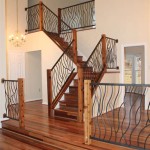Interior Design Home Ideas: Creating Functional and Beautiful Living Spaces
Interior design encompasses more than just aesthetics; it is a meticulous process of shaping the interior of a space to optimize functionality, safety, and visual appeal. It involves analyzing the needs of the occupants, understanding architectural elements, and applying design principles to create an environment that is both comfortable and conducive to its intended purpose. Whether renovating an existing home or designing a new one, thoughtful interior design can transform a space into a personalized sanctuary that reflects individual style and enhances daily life.
A well-designed home not only looks appealing but also improves the overall quality of life for its inhabitants. It can contribute to increased productivity, reduced stress levels, and enhanced social interactions. This article explores several key interior design ideas that can be implemented to achieve a harmonious and functional living space. From optimizing space utilization to selecting appropriate color palettes and materials, each element plays a crucial role in creating a cohesive and inviting home environment.
Optimizing Space and Functionality
One of the fundamental aspects of interior design is maximizing the available space and ensuring that it functions efficiently. This involves considering the layout, furniture placement, and storage solutions to create a livable and organized environment. In smaller homes, clever space-saving strategies are particularly important, while larger homes benefit from zoning and strategic furniture arrangements to define different living areas.
Layout and Flow: The layout of a home should facilitate easy movement and create a natural flow between different rooms. Avoid cluttering pathways and ensure that furniture is arranged in a way that allows for comfortable circulation. Consider the placement of doorways and windows when planning the layout to optimize natural light and ventilation. In open-plan living areas, use furniture pieces like sofas or rugs to delineate different zones, such as a living area and a dining area.
Multifunctional Furniture: Investing in multifunctional furniture is an excellent way to maximize space in a home. Sofa beds, storage ottomans, and dining tables with extendable leaves can serve multiple purposes, reducing the need for additional furniture and freeing up valuable floor space. Wall-mounted desks and shelves are also ideal for small spaces, as they provide workspace and storage without taking up floor area.
Storage Solutions: Adequate storage is essential for maintaining an organized and clutter-free home. Built-in shelves, custom cabinetry, and under-bed storage are effective ways to maximize storage space. Utilize vertical space by installing shelving units that reach the ceiling. In the kitchen, consider pull-out drawers, pantry organizers, and lazy Susans to optimize storage efficiency. In bathrooms, medicine cabinets, vanity organizers, and towel racks can help keep the space tidy and organized.
Zoning and Activity Areas: In larger homes, defining different activity areas can help create a more functional and organized living space. For example, a dedicated reading nook with a comfortable armchair and a bookshelf can provide a quiet and relaxing area for reading. A home office with a desk, ergonomic chair, and storage cabinets can provide a focused workspace. By defining specific areas for different activities, it becomes easier to maintain a sense of order and functionality throughout the home.
Selecting Color Palettes and Materials
The selection of color palettes and materials plays a significant role in shaping the atmosphere and aesthetic appeal of a home. Colors can evoke different emotions and create a sense of harmony or contrast, while materials can add texture, warmth, and visual interest to a space. Considering the overall style of the home and the individual preferences of the occupants is crucial when choosing colors and materials.
Color Psychology: Understanding the psychology of colors can help create a desired mood and atmosphere in a home. Warm colors like red, orange, and yellow can create a sense of energy and excitement, while cool colors like blue, green, and purple can promote relaxation and tranquility. Neutral colors like white, gray, and beige can provide a versatile backdrop that complements a variety of styles and colors. When choosing colors, consider the amount of natural light in the room, as well as the existing furniture and décor.
Material Selection: The choice of materials can significantly impact the overall look and feel of a home. Natural materials like wood, stone, and leather can add warmth and texture, while synthetic materials like metal, glass, and plastic can create a more modern and minimalist aesthetic. Consider the durability, maintenance requirements, and environmental impact of the materials. For example, hardwood floors are durable and easy to maintain, while carpets can add warmth and softness to a room. In bathrooms and kitchens, consider using water-resistant materials like tile or stone to prevent moisture damage.
Creating Visual Interest: Combining different colors and materials can create visual interest and depth in a home. Use contrasting colors to create focal points and highlight architectural features. Experiment with different textures to add tactile appeal. For example, pairing a smooth leather sofa with a textured rug can create a visually appealing contrast. Using patterns, such as geometric prints or floral motifs, can also add visual interest to a room.
Lighting and Color Perception: The type of lighting used in a home can significantly impact the perception of colors. Natural light tends to enhance the true colors of materials, while artificial light can alter colors depending on its temperature and intensity. Consider the color rendering index (CRI) of light bulbs to ensure that they accurately represent the colors of the materials in the room. Layering different types of lighting, such as ambient lighting, task lighting, and accent lighting, can create a more balanced and versatile lighting scheme.
Incorporating Personal Style and Décor
Personalizing a home with décor that reflects individual style and interests is essential for creating a space that feels comfortable and inviting. This involves selecting artwork, accessories, and furniture pieces that resonate with the occupants and add character to the home. Incorporating personal mementos, family heirlooms, and travel souvenirs can further personalize the space and create a sense of connection to the past.
Artwork and Wall Décor: Artwork can add personality and visual interest to a home. Choose artwork that reflects individual taste and complements the overall style of the home. Consider the size and scale of the artwork in relation to the wall space. Hanging artwork at eye level ensures that it is easily visible and appreciated. Other forms of wall décor, such as mirrors, tapestries, and decorative plates, can also add visual interest and texture to a room.
Accessories and Accents: Accessories and accents can add the finishing touches to a home and personalize the space. Throw pillows, blankets, vases, and candles can add color, texture, and warmth to a room. Arrange accessories in groupings to create visual balance and interest. Consider the scale and proportion of accessories in relation to the furniture and other décor items. For example, a large vase on a small side table might look out of proportion.
Furniture Style and Arrangement: The style and arrangement of furniture can significantly impact the overall look and feel of a home. Choose furniture pieces that reflect individual taste and complement the architectural style of the home. Consider the size and scale of the furniture in relation to the room. Avoid overcrowding rooms with too much furniture, as this can make the space feel cramped and cluttered. Arrange furniture in a way that facilitates conversation and creates a comfortable and inviting atmosphere.
Incorporating Personal Mementos: Personal mementos, family heirlooms, and travel souvenirs can add character and personality to a home. Display these items in a way that tells a story and reflects individual experiences. Create a gallery wall with family photos or display travel souvenirs on shelves or in display cases. Incorporating personal mementos can create a sense of connection to the past and make the home feel more personal and meaningful.
Implementing these interior design ideas can help transform a house into a home that is both functional and beautiful. By carefully considering space utilization, color palettes, materials, and personal style, it is possible to create a living space that enhances daily life and reflects individual identity.

10 Modern Home Interior Design Ideas All You Need To Know A House In The Hills

13 Creative Home Decor Ideas To Transform Your Space

Latest Interior Design Ideas For Your Home Decor Wooden Street

18 Interior Design Ideas Home

7 Easy Home Interior Design Ideas That Will Help A Dreamlike Decor Without Hassles Miradorlife

9 Small House Interior Design S To Try Beautiful Homes

Living Room Decor Ideas For Your Home Design Cafe

100 Home Decor Ideas The Ultimate Inspiration For Interior Designers

Latest Interior Design Ideas For Your Home Decor Wooden Street

Home Decor And Interior Design Ideas For Every Room Jk Cement
Related Posts








